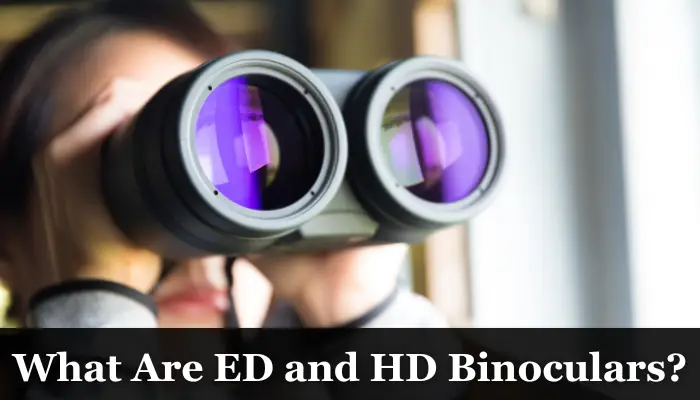This post may contain affiliate links which means I may receive a small commission for purchases made through the links. Learn More
Binoculars are super useful tools, and the manufacturers are making them even more useful by incorporating newer technology. In the past, the visual quality of binoculars was not up to the mark. But things have changed now.
The manufacturers use special lenses such as ED or HD, which enhance the quality of the images you see through the barrel of the binoculars. Are abbreviations such as ED, and HD confusing you?
Don’t worry, as this will be dedicated to these types of lenses. I will explain both ED and HD binoculars so that you understand their differences and ensure that you make the right decision when the time arrives.
Related Article: What Are Dielectric Prism Coatings on Binoculars?
Overview of ED Binoculars

ED binoculars consist of ED lenses. ED stands for Extra-low Dispersion. The ED lenses are actually made with ED glasses which are specialized in reducing or eliminating the chromatic aberration from the visuals.
I know that you don’t understand the meaning of the chromatic aberration. Actually, it is a phenomenon that occurs when the light of different wavelengths doesn’t meet or converge on the same focal plane.
If you learn more about the ED binoculars, then I highly recommend you to read our other guide on working of ED binoculars. You’ll get complete insight about the ED binos.
Binoculars that produce chromatic aberration are considered ordinary because the user finds it hard to view the target clearly. To reduce the chromatic aberration, the ED glasses ensure that the light of different wavelengths converges at one point.
You should also keep in mind that the ED glasses are made with calcium fluoride which has special properties of low dispersion. It is key for the functionality of the ED lenses.
Mechanism of ED Lenses
As said earlier, ED lenses are made with ED glass which has very low dispersion. Usually, when the light passes through a glass, then it gets refracted at different angles. So, the light fails to converge at one focal point.
But in the case of ED glass, when the light passes through the ED glasses, it does not get refracted randomly at different angles. Instead, it refracts more consistently and smoothly.
So, the light of different wavelengths reaches one focal plane as they refract more consistently and smoothly. When the light of all the wavelengths converges at one focal plane, you tend to see more clear, lifelike color in the visuals.
If the light fails to converge at one point, then you will see color fringing in the visuals that are obviously not good. You won’t be able to see the visuals clearly. But in the ED binoculars, all the light converges at one point after refraction, so you see perfect visuals.
What are HD Binoculars?

HD represents the ”High definition”. In terms of HD binoculars, represent HD glasses that have special properties to reduce glare production in the visuals. They are capable of increasing the anti-reflection and ensuring that the users see nice visuals.
The HD binoculars consist of top-notch lenses which are coated with some anti-reflective material to reduce the reflection of light. As you know when the reflection of light happens, some amount of light gets lost which is not a good thing if you aim to achieve better visual quality.
So, these lenses are coated in a way that they become efficient in reducing the reflection of light and improving the transmission of light. In this way, the maximum amount of light reaches the users.
More light means that the user will be able to see more brighter, and sharper visuals. Due to the reduction of reflection of light, the glares are not produced in the visuals. This is why I said that the HD binoculars offer vivid, brighter, high-resolution visuals without any glaring production.
Don’t be confused when I say that these HD binos reduce the glares or unwanted light on the visuals. The transmission of light ensures that balance of brightness, and colors in the image. You won’t notice any dark or shiny spots on the images when using the HD binoculars. Thanks to better transmission of light.
Also Read: What Is BAK-4 Prism in Binoculars?
Difference Between ED and HD Binoculars
Both ED and HD have their benefits and they help in their own way. However, ED binoculars are helpful in producing visuals without any chromatic aberration, and HD binoculars are super helpful in giving brighter, vivid, and high-solution visuals.
The ED binoculars actually bring the light of different wavelengths at one focal plane and reduce the color fringing (chromatic aberration). By doing so, these binoculars produce visuals with edge-to-edge clarity and sharpness.
The HD binoculars are different from the ED binoculars as they usually have nothing to do with chromatic aberration. Instead, the HD binos consist of glasses that have anti-reflection coatings that reduce the reflection and enhance the transmission of light.
When the transmission of light increases, more light reaches the eyepiece, and you end up seeing brighter, sharper, and more attractive visuals instead of dim or hazy images. This is the whole difference between these two binoculars.
ED vs HD Glass Binoculars: Comparison Table
In the above section, I have given the complete explanation of how these two HD, and ED binoculars work and offer excellent visuals. In the section below, I am giving a comparison table that will help you understand the detailed differences between these two ED and HD binoculars.
| ED Binoculars | HD Binoculars |
| Reduce Chromatic Aberration for color accuracy | Enhance Brightness, Vividness, and High Resolution |
| ED glass with low dispersion properties | HD glass or coated lenses for improved transmission |
| Minimizes Chromatic Aberration (Color Fringing) | Focuses on reducing glare and improving transmission |
| True-to-Life Colors with Reduced Fringing | Emphasizes Bright and Vivid Visuals |
| Edge-to-Edge Clarity and Sharpness | High-Resolution Images with Enhanced Contrast |
| Utilizes Calcium Fluoride in ED glass for dispersion | Coated lenses with anti-reflective materials |
| Consistent and Smooth Refraction for Clear Images | Improves Light Transmission for Brightness |
| Brings Light of Different Wavelengths to One Plane | Reduces Reflection and Ensures Efficient Transmission |
| Ideal for Color Accuracy Tasks (e.g., Birding) | Suited for Observations Requiring Brightness |
| Minimizes Color Fringing for Sharpness | Emphasizes Brightness for Clear and Sharp Visuals |
| Primarily Addresses Chromatic Aberration | Specifically Addresses Reflection for Brightness |
ED Glass Vs HD Glass: Basic Difference
The ED glasses represent the Extra low dispersion glass whereas the HD glasses represent the high-definition glass. Both types of glasses are used in the binoculars to improve the optical performance of the binoculars.
The ED glass is known due to its low dispersion properties. It reduces the chromatic aberrations from the visuals and offers edge-to-edge clarity. On the other hand, the HD glasses are coated with anti-reflective material to increase the transmission of light by reducing the reflection of light.
Both types of glasses are excellent in their own ways. If you aim to see brighter and sharper visuals, I suggest you go with HD glasses and binoculars. On the other hand, if you aim to get an image with no chromatic aberration or color fringing, you should go with ED glass binoculars.
Which one Should You Choose: ED or HD Binoculars?
Well, this is interesting, as everyone has their own needs and preferences. What I prefer may not be ideal for you. At the same time, what you like in binoculars is not important to me. That’s why I suggest you make your own decision by understanding all the details of ED, and HD binoculars.
One thing that I would love to mention is that binoculars are tools that come with different specifications. Each outdoor activity requires a different specification. In the section below, I am going to mention some of the popular activities and what type of binoculars you should use.
| Activity | Binoculars Type | Reasoning |
| Hunting | HD Binoculars | Enhanced brightness and clarity are crucial for spotting games at a distance. |
| Bird Watching | ED Binoculars | Color accuracy is important for bird identification, and ED binoculars reduce chromatic aberration. |
| Sightseeing | HD Binoculars | HD binoculars provide vivid visuals and high-resolution images, enhancing the overall sightseeing experience. |
| Stargazing | ED Binoculars | ED binoculars minimize chromatic aberration, providing clear views of celestial objects during stargazing. |
| Hiking | Compact HD Binoculars | Compact and lightweight HD binoculars are suitable for hiking, offering portability without compromising performance. |
My Own Verdict Over HD vs ED Binoculars
I personally prefer the ED binoculars over HD as it reduces the chromatic aberration so I become able to see everything clearly. Keep in mind that these bones are slightly more expensive than HD binoculars.
However, if you are going to use binoculars in low light conditions, and aim to see an object which is not very far away, then you should choose HD binoculars as they will provide you with more brighter, and sharper visuals.
If you are going to see the target which is very far away from you, then make sure that you choose the ED binoculars so that you get the visuals free from the chromatic aberration. For close-range viewing, HD binos are more than enough.
Ideal case Scenario:
There are many brands which are producing binoculars that are both ED and HD. The prices of such binos are higher. If you have the handsome budget, you should buy those as they will offer you brighter, and sharper visuals without any chromatic aberration or color fringing
Conclusion
I think that we have discussed enough about the ED and HD binoculars. In short, the ED glass used in the binoculars reduces the chromatic aberration whereas the HD glasses reduce the reflection because they are coated with anti-reflective material. Hopefully, this detailed article will prove to be helpful.

I’m a passionate outdoor activist who has got special love for optics. The school studies in optical mechanics and the travelling experience has made me an expert in optics like binoculars, scopes, and other devices. Stay connected with us for in-depth knowledge!

